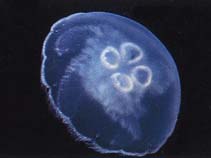Advertisement
Aurelia aurita (Linnaeus, 1758)
Moon jelly| Native range | All suitable habitat | Point map | Year 2050 |

|
| This map was computer-generated and has not yet been reviewed. |
| Aurelia aurita AquaMaps Data sources: GBIF OBIS |
France country information
Common names:
[No common name]
Occurrence: native
Salinity: marine
Abundance: | Ref:
Importance: | Ref:
Aquaculture: never/rarely | Ref:
Regulations: no regulations | Ref:
Uses: no uses
Comments:
National Checklist:
Country Information: https://www.cia.gov/library/publications/resources/the-world-factbook/geos/fr.html
National Fisheries Authority:
Occurrences: Occurrences Point map
Main Ref: Carpine, C., 1987
National Database:
Occurrence: native
Salinity: marine
Abundance: | Ref:
Importance: | Ref:
Aquaculture: never/rarely | Ref:
Regulations: no regulations | Ref:
Uses: no uses
Comments:
National Checklist:
Country Information: https://www.cia.gov/library/publications/resources/the-world-factbook/geos/fr.html
National Fisheries Authority:
Occurrences: Occurrences Point map
Main Ref: Carpine, C., 1987
National Database:
Common names from other countries
Classification / Names Tên thường gặp | Các synonym ( Các tên trùng) | Catalog of Fishes (gen., sp.) | ITIS | CoL | WoRMS
Environment: milieu / climate zone / depth range / distribution range Sinh thái học
Tầng nổi; Thuộc về nước lợ; Mức độ sâu 0 - 1250 m (Tài liệu tham khảo 116114). Subtropical; 78°N - 55°S, 180°W - 180°E
Distribution Các nước | Các khu vực của FAO | Các hệ sinh thái | Những lần xuất hiện | Những chỉ dẫn
Circumglobal. This species is widespread in all the seas of the sphere, from the equator to the poles. Subtropical to polar.
Length at first maturity / Bộ gần gũi / Weight / Age
Maturity: Lm ?, range 2 - 31 cm Max length : 50.0 cm WD con đực/không giới tính; (Tài liệu tham khảo 2376)
Short description Hình thái học
Maximum diameter: 50 cm (Ref. 358); Height, from 10 to 12.5 cm; diameter, being able to reach 40 to 50 cm (Ref. 363). Plane sunshade; comprising very many tentacles courts with the periphery. One counts 4 oral arms; and 4 sexual organs; of annular form or in the horseshoe shape very many radiate channels. Coloring: generally translucent, with slightly pink reflections, blue or purple; the sexual organs are more clearly colored red or pink (Ref. 358).
This species is being eaten by predators because of its high fatty acid content (Ref. 122155). Neritic, potentially pathogenic (Ref. 116114). Free living near the water's surface in pelagic zones (Ref. 2997), close to coasts (Ref. 358), and offshore (Ref. 813); also found in brackish waters (Ref. 2993), coastal embayments, fjords and estuaries (Ref. 3289). Their cnidocytes cannot transpierce the human skin. Suspension feeder (Ref. 3269) on tintinnids, rotifers, cladocerans and larvae of copepods (harpacticoid), barnacles (nauplii; Ref. 3053) and on fish larvae (Ref. 7715). Several cases reported sea anemones to feed on this species; fungiid coral is also an occasional feeder. Provides vital fatty acids for fishes and crustacean predators. Nutritional value of this species from macronutrients and key fatty acids appears to be important over only meeting a predator's energy demands (Ref. 122155).
Life cycle and mating behavior Chín muồi sinh dục | Sự tái sinh sản | Đẻ trứng | Eggs | Sự sinh sản | Larvae
High abundances of ephyrae during late autumn can be explained by the large number of poly disc scyphistomae preceding to the appearance of ephyrae (Ref. 3062). Polyps begin to develop in August-September, matures in October and dies in November (Ref. 3271). Budding doesn’t occur in winter months (Ref. 7721). Can live up to 2 years (Ref. 3049).
Main reference
Các tài liệu tham khảo | Người điều phối | Người cộng tác
Wrobel, D. and C.E. Mills. 1998. (Tài liệu tham khảo 2376)
IUCN Red List Status
(Tài liệu tham khảo 130435: Version 2024-2)
CITES status (Tài liệu tham khảo 108899)
Not Evaluated
CMS (Tài liệu tham khảo 116361)
Not Evaluated
Human uses
Các nghề cá: Tính thương mại
| FishSource |
Các công cụ
Thêm thông tin
Các nước
Các khu vực của FAO
Các hệ sinh thái
Những lần xuất hiện
Những chỉ dẫn
Stocks
Sinh thái học
Thành phần thức ăn
Các loại thức ăn
Các khu vực của FAO
Các hệ sinh thái
Những lần xuất hiện
Những chỉ dẫn
Stocks
Sinh thái học
Thành phần thức ăn
Các loại thức ăn
Tên thường gặp
Các synonym ( Các tên trùng)
Các động vật ăn mồi
Sự tái sinh sản
Chín muồi sinh dục
Đẻ trứng
Sự sinh sản
Eggs
Egg development
Các synonym ( Các tên trùng)
Các động vật ăn mồi
Sự tái sinh sản
Chín muồi sinh dục
Đẻ trứng
Sự sinh sản
Eggs
Egg development
Các nguồn internet
BHL | BOLD Systems | CISTI | DiscoverLife | FAO(Publication : search) | GenBank (genome, nucleotide) | GloBI | Gomexsi | Google Books | Google Scholar | Google | PubMed | Cây Đời sống | Wikipedia (Go, tìm) | Tạp chí Zoological Record
Estimates based on models
Preferred temperature
(Ref. 115969): 4.7 - 25.3, mean 12.3 (based on 3533 cells).
Thích nghi nhanh
(Tài liệu tham khảo 69278)
Chiêù cao, thời gian nhân đôi của chủng quần tối thiểu là dưới 15 tháng (K=0.45-3.83).
Price category
(Tài liệu tham khảo 80766):
Unknown.




